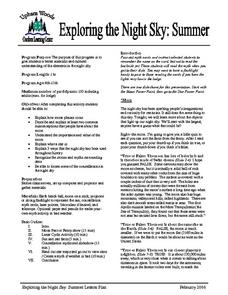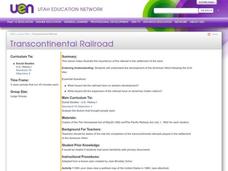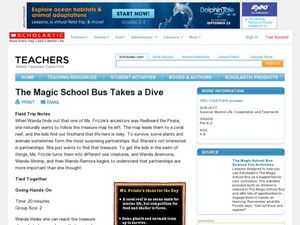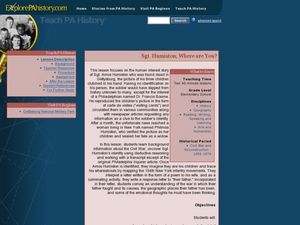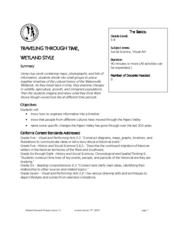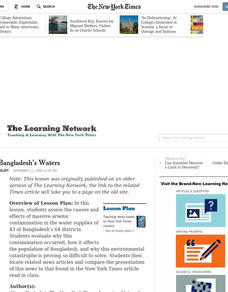Curated OER
A Neighborhood Expedition
Students plan and conduct an expedition through their neighborhood based on the techniques used by the Harriman Expedition to Alaska in 1899. They research the Harriman expedition on the internet and then create a route and collection...
Curated OER
A New Federation
Students describe the relationships between state and federal parliaments in Australia. They identify responsibilities shared between federal and state and territory governments. Students explore an alternative federal structure by...
Curated OER
Rulers For a Day
Students design and create foil coins with images that symbolize students' imaginary leadership in the ancient world. They model their coins on those made for Alexander the Great. They discuss what made him an important historical figure.
Curated OER
Blackout!
Students read news reports and first-person accounts of a blackout in a large city and keep weblogs or journals. They take on different roles of people who live in the city or commute there to work and then use their journal accounts to...
Curated OER
Watersheds and Wetlands
Learners discuss the idea of a watershed. They build models of watersheds using paper and observe what happens to their models when it "rains". In addition, they build a second watershed to compare watersheds with wetlands to those without.
Curated OER
Exploring the Night Sky: Summer
Students explain how moon phases occur. They describe and explain at least two common misconceptions that people have about the moon. Students explain what a star is. They explain 3 ways that the night sky has been used throughout history.
Curated OER
How Big is Big?
The blue whale is the focus of this life science activity. Students read an excellent selection on the blue whale, and answer ten comprehension questions. Then, students are divided into two groups. Each group has to estimate how big 85...
Curated OER
The Clever Monkey Rides Again
Students explore a West African folktale. In this folktale lesson, students read the book The Clever Monkey Rides Again and discuss the trickster characters from the tale. Students participate in a discussion about the folktale and...
Curated OER
Scenario challenge
Fifth graders become familiar with the geography of New Hampshire and the importance of specific sites in history. In this New Hampshire lesson, 5th graders create a brochure including points of interest and showing distances between...
Curated OER
Transcontinental Railroad
Eleventh graders explain the development of the American West following the Civil War. They also explore the Homestead Act of 1862 and the Pacific Railway Act of 1862. They also participate in a simulation about the American West.
Curated OER
Explorers of the New World
Students research explorers and explore how exploration affected the Western Hemisphere; students demonstrate competency in using multimedia encyclopedia and information software, and present PowerPoint presentation to class with two...
Curated OER
The Early Peoples
Students, after studying The Early Peoples, explain and give examples of how Native Americans and Europeans adapted to living in certain environments. They give examples of early cultures and settlements that existed in North America...
Curated OER
Talking Sticks
In this nature worksheet, students read about Australian Aboriginals. Students read about the talking sticks they used as a means of ensuring just and impartial council meetings.
Curated OER
The Magic School Bus Takes a Dive
Learners learn along with Ms. Frizzle's class. In this Magic School Bus lesson plan, students find out how partners can help run a race just as Wanda learns that survival on the coral reef often depends on cooperation.
Curated OER
Sgt. Humiston, Where are You?
Students become familiar with the events of the Civil War. In this identification lesson, students use deductive reasoning to understand how the deceased soldier was identified. Students view primary documents for information about the...
Curated OER
City Life In Europe
Middle schoolers explore Paris. In this geography skills lesson, students watch "City Life in Europe," and conduct further research on the city of Paris and the country of France. Middle schoolers create postcards that feature Parisian...
Curated OER
Geography of China (Tibet): Dalai Lama Day Three of Five
Sixth graders research another culture. In this geography and culture lesson, 6th graders read about the geography of Tibet, compare the United States and Tibet, use various resources to research information about Tibet and discuss what...
Curated OER
Traveling Through Time, Wetland Style
Learners create a timeline on the development of the Pajaro Valley Area. In this social science lesson, students discuss the changes that took place in the area over the past 300 years. They draw a pictures of how the area has changed...
Curated OER
Testing Bangladesh's Waters
Students assess the causes and effects of massive arsenic contamination in the water supplies of 43 of Bangladesh's 64 districts. They evaluate why this contamination occurred, and how it affects the population of Bangladesh.
Curated OER
In the Heart of Your City
Students analyze the changes in the community described in "Still a Contender on the Waterfront" and evaluate how the history of a city can be seen, regardless of changes, in a city as it exists today.
Curated OER
Amidst the Rubble of Ruined Cities
Students, in committees, develop and propose solutions to rebuild various elements of Colombia's infrastructure in the wake of the January 25, 1999 earthquake, as well as compare and contrast the earthquake's affects on Colombia to an...
Curated OER
Taiwan on Shaky Ground
Students, in groups, examine how various elements of Taiwan's infrastructure were affected in the September 21, 1999 earthquake by analyzing a number of newspaper articles on the quake and its aftermath.
Curated OER
Reporter's Notebook
Students research the geography and history of a major city in Iraq. They write a journal from the perspective of a war correspondent stationed in that city.
Curated OER
Spy vs. Spy?
Learners consider their beliefs about proper and improper surveillance and then create imaginary neighborhoods featuring surveillance technology in various public and private sites.







